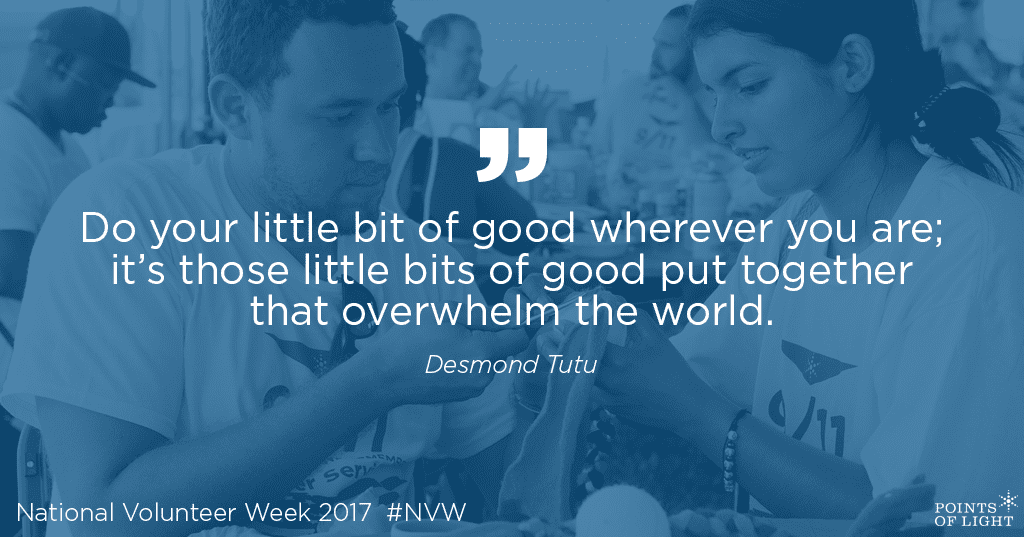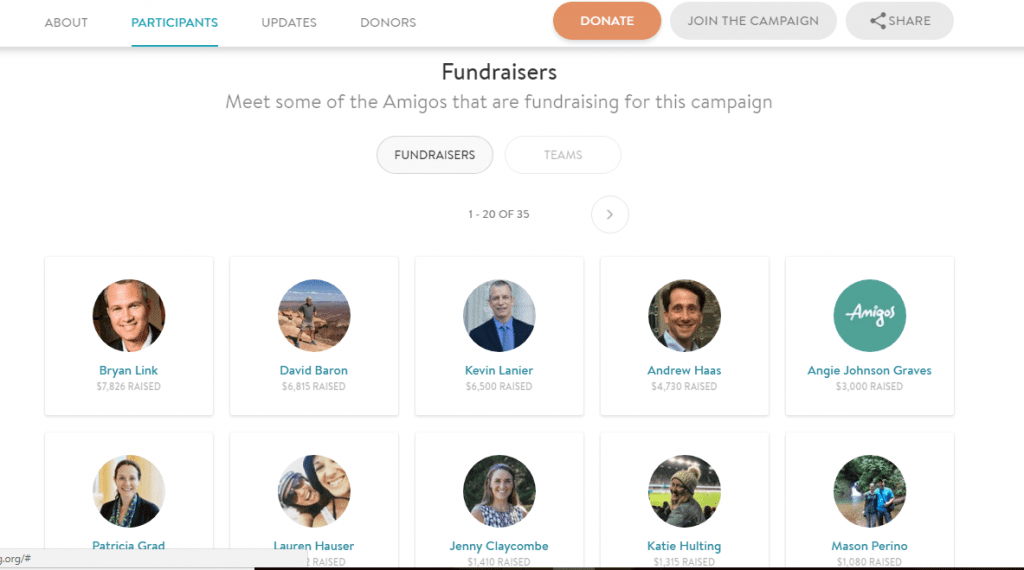You’ve recruited some volunteers. Congratulations! That’s awesome!
Volunteers make the nonprofit world go round. At their best, they’re advocates for your cause, relieve burdens from your staff, and expand your organization’s reach and impact. Let’s do a small dance of joy right now.

- WOOHOO! WE’VE GOT VOLUNTEERS!
So, how are you going to keep them?

- “Just hope they stay?”
No worries, we’re here at CauseVox to help you engage, retain, and empower your volunteers, giving them the best volunteer experience they’ve ever had.
What Makes A Good Volunteer Experience?
A good volunteer experience is good all around–the volunteer helps the organization, and volunteering serves the volunteer in some way. Instead of money, nonprofits offer volunteers personal satisfaction. Volunteers can get satisfaction from making a difference, using their professional skills for good, connecting with the population you serve, meeting new people, and building new skills.
Volunteer management takes a lot of attention to detail, so it’s easy to lose sight of the overall experience your volunteers are having. Before you start planning meetings and writing up volunteer handbooks, take some time to think about what a good volunteer experience with your organization might be.
Pay particular attention to how you want people to feel when they volunteer at your organization. Consider making that feeling your mission as you manage volunteers, as in:
“My mission is to make every volunteer feel confident in their role.”
“My mission is to make every volunteer feel supported by this organization.”
“My mission is to make every volunteer feel excited about learning more about our cause.”
(Side note: Some volunteers will not cooperate with your personal mission. Everyone is allowed to feel however they darn well please. You should still have a goal.)
It may be hard to slow down and articulate some of this squishy-feel-good stuff, especially if managing volunteers is not your full-time job. It’s worth it, though. The emotional component of volunteering can’t be underestimated; if people don’t feel good, they won’t keep volunteering.
A 3-Part Strategy For Volunteer Management

- Go, team!
Effective volunteer management starts before you even recruit your first volunteer, and continues at every step of their engagement with your organization. Whatever your volunteer opportunities, roles, or assignments, make sure you’re planning to engage, retain, and empower your volunteers.
Engage
Engagement means continually capturing your volunteers’ attention, inspiring them to give their time. An engaged volunteer is excited about working with your organization, ready to learn, and knows what is expected of them.

- Passion leads volunteers, engagement keeps them.
Strategies for Engagement
1) Give Them Something To Do ASAP
As soon as someone becomes a volunteer at your organization, offer them something to do. Their initial excitement will dwindle if they complete an orientation and then aren’t given a chance to get started for months.
If you don’t have an immediate need for volunteers, invite them to meet people within the organization, shadow a staff person, or tour your offices. Anything you can do to make them feel included immediately will build their connection to your organization.
2) Train And Explain
People volunteer because they want to help. If they feel like they are in the way, unprepared, or liable to mess something up, their volunteer experience won’t be satisfying. Describe volunteer opportunities thoroughly and accurately, and make sure you take the time to adequately explain volunteer roles, responsibilities, and procedures. Pair them with more experienced volunteers before asking them to do something on their own.

- This volunteer opportunity clearly spells out the expectations, time and skills needed, and benefits of volunteering.
People learn differently, so it’s helpful to provide information to volunteers in more than one way. A volunteer handbook may be just what one person wants, while another will benefit more from watching someone do a task. By delivering training information in different ways, you give more volunteers the chance to be successful.
Situations that call for volunteers are often busy and stressful, but make sure new volunteers have a chance to ask questions about what you’re asking them to do.
3) Follow Up
You’ll learn a lot about your new volunteers, and potentially about your organization, if you follow up after the first couple times a volunteer works with you. It doesn’t need to be an entire procedure, but checking in gives you the chance to see how it’s going. You can reassure, encourage, and congratulate a new volunteer, as well as head off any problems or misunderstandings.
Ask questions that are:
-
- Open-ended, rather than “yes” or “no”: “What was your favorite part of the day?” or “What was the most challenging?”
- Collaborative: “How did the information you received before volunteering prepare you? Did you need more, or different information? How can we help the next new volunteer better?”
- Address their expectations: “What did you expect volunteering to be like? How did your experience compare to your expectations?
- Warm and casual: “How’d you feel about yesterday?”
The warm and casual part is important. You don’t want your new volunteer to feel like something went wrong, or they’re getting a pop quiz. Use relaxed language and a friendly tone of voice.
Retention
People stop volunteering all the time. Some of the reasons they leave are beyond our control. We really can’t do much about people moving away, having babies, or getting really busy at work. We can do a lot about people feeling disappointed, unappreciated, underutilized, and bored.
1) Appreciation
Thank your volunteers as much as you can, and then thank them again. They are giving you their time and energy in order to help make a difference–this is a gigantic and beautiful thing, and they must know you appreciate it. Drop them a note, give them a call, recognize them at public events. Highlight their contributions on National Volunteer Week. The sky’s the limit.

- Put National Volunteer Week on your calendar right now.
2) Organization and Timeliness
Do not waste the time volunteers give you. Take wasting their time as seriously as you take wasting donors’ money. Demonstrate the respect you have for your volunteers’ generosity by:
- Starting and ending events on time
- Being prepared when the volunteers arrive
- Supplying them with everything they need to do the work you’re asking them to do
- Only calling the number of volunteers you actually need
- Offering schedule options for mandatory meetings like orientations and trainings

- Volunteers don’t stay at organizations that waste their time.
3) Communication and Listening
Keep volunteers in the loop. Consider sending a volunteers-only monthly e-update or newsletter to communicate opportunities and new information, and share stories. Just like donors, volunteers want to know how their contributions make a human impact. Stories deepen their investment in your organization.
In addition to keeping them up to date on volunteer opportunities and wowing them with impact stories, make sure your volunteers know what’s going on at your organization. Staff changes? New programs? Your volunteers should be among the first to know about them.
Communication is a two-way street–keep those check-ins going! Volunteers have a unique view of your organization and the work you do, but they might not tell you unless you ask. Listening gives you the opportunity to address the kinds of issues that make people stop volunteering, before you lose the volunteer.
4) Offer A Variety Of Volunteer Opportunities
Some volunteers really do just want to stuff envelopes. They will be perfectly content to do the same volunteer assignment for years. Others will will get bored if they never get to do anything else.
It’s easy to go to the people you know can do a job over and over again, but resist the temptation. If your “favorite” volunteers get asked to do everything, they run the risk of burnout, while other volunteers might feel left out. Give people a chance to try something new.
There’s a great post over at Bloomerang about retaining volunteers (and donors), drawing examples from the children’s book, The Day the Crayons Quit. Make sure you’re using all the colors in your crayon box, and that you don’t wear your “blue crayon” volunteers down to stumps, while your “beige crayon” volunteers sit waiting in the box.
Make it easy for volunteers to stick with you by offering volunteer opportunities with different time commitments. If the only way to volunteer for your organization requires two hours a week, you’ll lose a lot of people who can’t maintain that level of involvement. If you offer a mix of opportunities that are one-offs, weekly, monthly, and flexible, people will have other options to stay involved if their volunteer needs change.
5) Connect Them To A Community
Volunteering should not be an isolating experience, especially because many people volunteer in order to meet new people. Create opportunities for your volunteers to get to know each other and connect on a deeper level, like:
- Introducing volunteers to each other before work starts
- Holding group reflections at the end of a day of volunteering
- Inviting them to share stories with other volunteers
- Hosting volunteer social events
Empower
Volunteers can be your secret superpower if you give them the chance. They can lead other volunteers, advocate for your organization, and even become fundraisers.

- Are your volunteers ready to take on more?
1) Step Back
Good training and support is important, but micromanaging does not empower volunteers. When someone has a handle on a volunteer job, continue to check-in, but get out of their way. Let the volunteer take some appropriate ownership of the task.
2) Volunteer Leadership
Some volunteers are ready for more. Take a look at your activities, and consider where your volunteers could step up. Could seasoned volunteers lead your volunteer orientations? Make volunteering schedules? Mentor a team of new volunteers?
Leadership and responsibility call for a deeper commitment to your organization. Look for volunteers who want to take that on.
3) Volunteer Advocates
If you’re looking to increase your organization’s reach and reputation (and who isn’t?), volunteers can be a tremendous help. Each of your volunteers is part of other communities and organizations. They’re alumni, and church-goers, and scout-leaders, and choir-members, and they’re often willing to share your stories and introduce your organization to their friends if you ask.
Volunteers can take your organization into communities you don’t even know about, where you may find new volunteers, donors, and resources for your cause.
4) Volunteer Fundraisers
Volunteers have a special authenticity when they talk about your organization, because working with you is not their job, but they do it anyway. Their endorsement means a lot. That’s part of what makes them fantastic peer-to-peer fundraisers.

- Volunteers are great fundraisers!
Peer-to-Peer Fundraising is a great volunteer opportunity, because:
- It helps volunteers share something that’s important to them with their friends and family
- Volunteers often really understand why you need the money–they’re the ones running out of new books to read to kids, or trying to start your broken-down food pantry van.
- It’s a flexible commitment that volunteers can do on their own
- It’s a very concrete way to contribute to your mission
- Some volunteers give time because they can’t give money (especially Millennials), and peer-to-peer fundraising gives them a way to contribute financially, too.
Good For Them, Good For You!
As you engage, retain, and empower your volunteers, remember: You’re doing this work for some truly terrific reasons. You’re helping people connect with a cause they care about, serve their communities, and make a difference. You’re helping your organization connect with the community, do more with less, and fulfill your mission.
Volunteer management is a lot, there’s no denying it, but also holds the possibility of a lot of joy. Start small if you’re feeling overwhelmed. You don’t have to build an entire management strategy this week.
Take a first step. Check in with your current volunteers, or start brainstorming how you want your volunteers to feel. Revise some volunteer job descriptions, or send a couple thank you notes. Look for opportunities for your seasoned volunteers to lead. Take one step, and then another, and you’ll be building a great volunteer experience in no time.
If You Liked This Post, Check Out:
Finding Nonprofit Volunteers To Support Your Mission
6 Tips To Help You Energize Your Peer-to-Peer Fundraisers
Editor's Picks
Ultimate Guide To Peer-to-Peer Fundraising
Customer Story: Spur Local Raises Over $1M With Their Give Local Campaign
Fundraising Strategies for Nonprofits: Craft the Best Approach for Your Organization
Create a Killer Fundraising Plan - Best Practices, Strategies, & Downloadable Template











